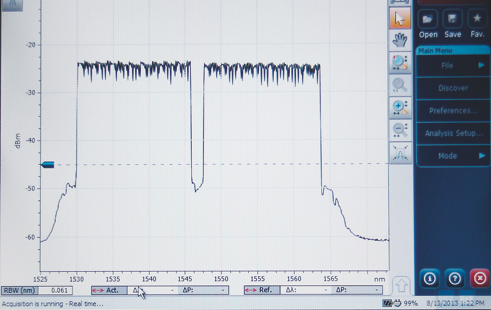Industry observers have described 2013 as ‘the year of 100G’. According to Infonetics Research, spending on wavelength-division multiplexed (WDM) equipment accelerated dramatically as a result of new 100G deployments. In fact, the market-research firm says that worldwide spending on 100G equipment is close to 15 per cent of all optical hardware spending, which itself totalled $3.3 billion (€2.4 billion) in the second quarter of this year.
Some kind of celebration seems justified, because the 100G market took a long time to reach maturity. Ciena, through its purchase of Nortel Networks’ optical division, has been selling 100G coherent optical systems since 2009. And, as the company recounts on its website, the preparatory work began a decade earlier, when engineers realised just how hard they would have to push the optics to achieve serial 100-Gbps transmission.
As the symbol rate on the optical fibre increases, non-linear effects such as chromatic dispersion and polarisation-mode dispersion (PMD) increase as the square of the symbol rate. Unsurprisingly, this increase in noise reduces the reach of the optical signal dramatically. In 1999, Nortel engineers had managed to achieve 80-Gbps serial optical transmission under laboratory conditions, but realised that their approach would only work in the real world if carriers put more signal regenerators into their networks and used high-quality optical fibre. Unfortunately, thanks to the dotcom bubble, there was a glut of unused optical fibre already in the ground, and nobody had the money or inclination to lay new fibre to attain higher speeds. Some fresh thinking was needed.
Record breakers
Optical equipment vendors declare world firsts on a fairly frequent basis, but it’s not often that one claims a Guinness World Record. In August, systems vendor Infinera and DANTE (Delivery of Advanced Network Technology to Europe), an operator of advanced networks for research and education, set a Guinness World Record for the fastest provisioning of multi-Terabit optical capacity.
The record was set using Infinera’s DTN-X optical transport platform, deployed on the pan-European research network GÉANT across a long-distance link from Vancis in Amsterdam, The Netherlands, to GlobalConnect in Hamburg, Germany. The total time from the insertion of the first 500G superchannel line card to the activation of the 100 Gigabit Ethernet service was 19 minutes and one second.

The adjudicators of the Guinness World Record for the fastest provisioning of multi-Terabit optical capacity: Sam Mason from Guinness World Records and Wolf Pueschner, formerly VP of Network Engineering for DTAG’s pan-European network, discuss the insertion sequence
Geoff Bennett, director of technology and solutions marketing at Infinera and leader of the record-breaking team, explains how it came about. ‘We’d just completed the 2Tbps in less than 12 minutes on the GÉANT network with DANTE, and the idea was raised that we could maybe get this rubber-stamped by the Guinness World Records (GWR) organisation. Unfortunately GWR doesn’t just rubber stamp record attempts. They actually take their role pretty seriously.’
First, Bennett had to persuade the officials that this was a valid record, and that it would be possible for other companies to try to break it. He put together a test specification that was approved by GWR, and spoke to several customers about hosting the record attempt.
Once again, DANTE stepped up – although a different route had to be found as the one used for the original demonstration was now in service and carrying live traffic.
Having already shown that 2Tbps was possible, Infinera decided to load up the equipment to its maximum, bringing up 8Tbps of optical capacity using 16 line cards. Any Guinness World Record has to be described by a single variable, which in this case was a provisioning rate of 26.02 Tbps per hour. That’s the figure that another organisation would need to beat in order to wrestle the record away from Infinera.

This is what 8Tbps looks like: 80 channels of 100G PM-QPSK displayed on an Optical Spectrum Analyser (OSA) that shows the C-Band, which is split into two sections (red and blue). The super-channels are so densely packed that the fine detail is hardly visible, except at the peaks
‘This is not just an intellectual exercise that we did,’ claimed Bennett. ‘The impact of cloud is making [bandwidth] demands bigger and lead times shorter.
‘This is genuine proof that we can bring up large amounts of capacity in short amounts of time.’


